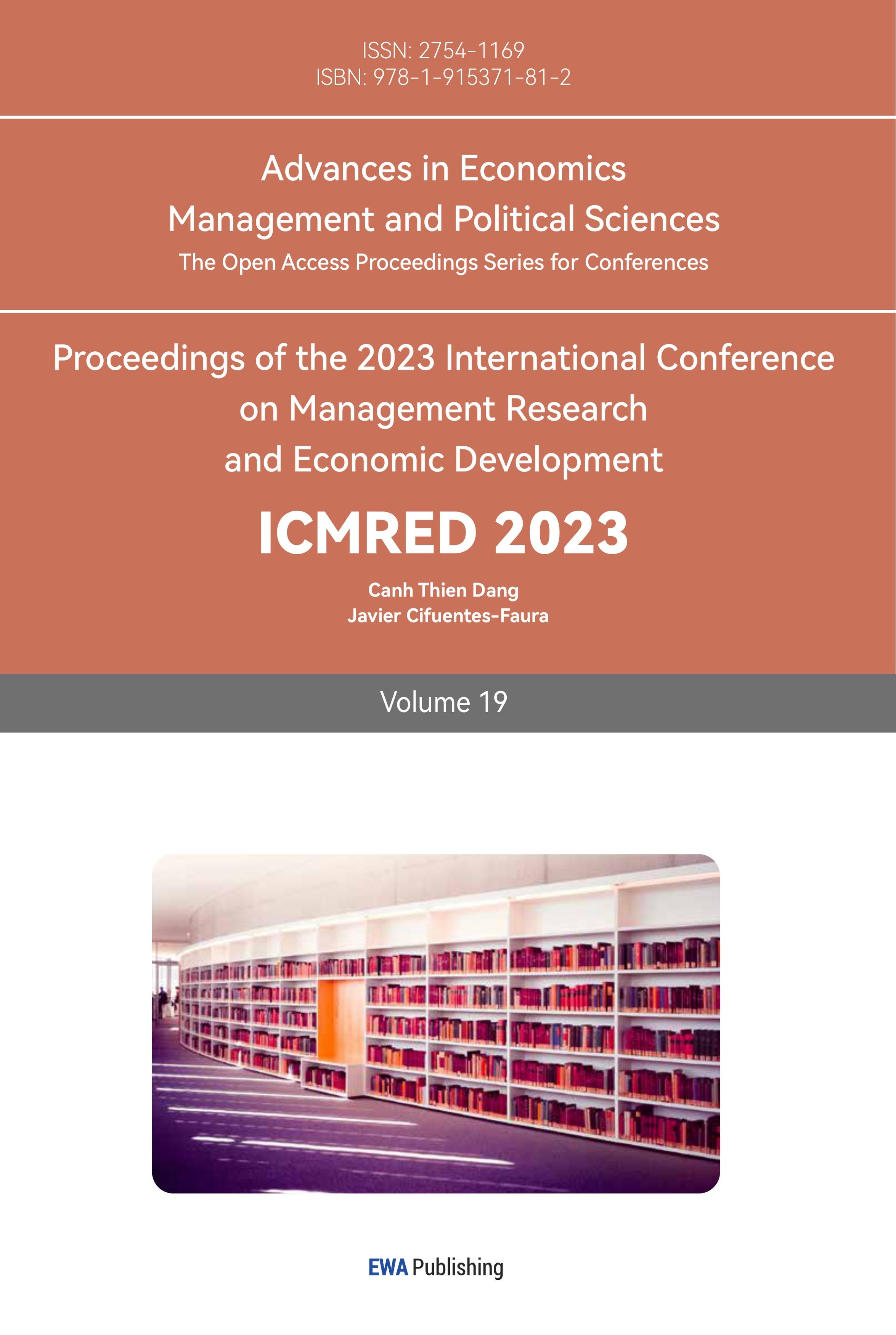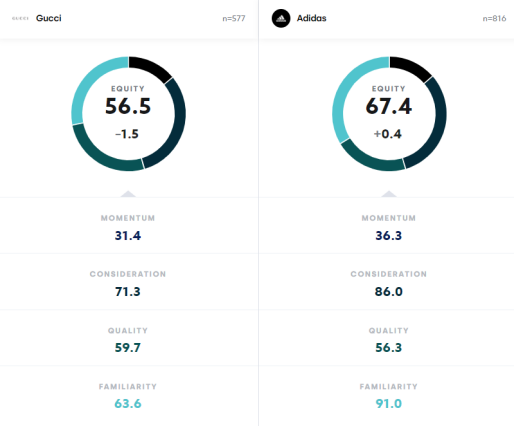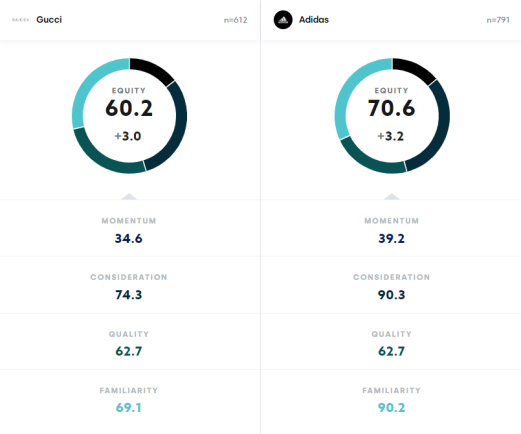1. Introduction
Co-branding has become a common phenomenon in the fashion industry. Brands hope to generate higher revenue and additional sales channels through co-branding. Most brands are no longer satisfied with only producing a single product, but are more eager to innovate through cooperation with other brands to achieve higher returns. Co-branding is a sales strategy, part of a strategic alliance, which uses the names of multiple brands for one or more products or services [1]. For example, the recent cooperation between some luxury brands, Balenciaga and Gucci, Gucci and Adidas, etc., has had a huge impact on fashion brand companies, and it is also an innovation in the sense that the joint cooperation between two brands or the act of combining two or more brands can create some new products. This paper takes Gucci, a fashion group, as an example to discuss, and uses a SWOT framework to analyze the opportunities and constraints encountered in co-branding initiatives. Under the effect of this co-branding cooperation, this paper can bring relevant enlightenment to the company through examples and comparisons that illustrate the different impacts co-branding can bring to enterprises.
2. An Introduction to the Co-branding Strategy of Gucci
2.1. The Cooperation Between Gucci and Balenciaga
In order to meet the needs and preferences of consumers, some fashion brands have begun to carry out joint brand cooperation and innovation with other brands. For example, Balenciaga and Gucci, compared with the previous products of the two brands, have made more changes to make consumers feel new. Balenciaga and Gucci have cooperated since April 2021. After that, Gucci's 2021 revenue increased by 42% compared to its 2020 revenue [2]. The launch of cross-border cooperation between the two fashion brands has created records and engagement on major social media platforms, and has helped these two brands achieve outstanding growth in the 2021 quarter. It can thus be shown that the purpose of co-branding is to attract more customers through the combination of two brands, and to maximize the strength and prestige of each brand. This partnership is very important for opening up new markets and boosting marketing opportunities [3]. This kind of sales strategy may increase the attention of consumers, and they may purchase a new innovative product because they like one of the base brands. The joint relationship can also bring great benefits to the brands of both parties, as it will satisfy some consumption needs. When cooperating with a stronger brand, the weaker brand can use the customer loyalty of the stronger brand to increase its own brand's revenue. Balenciaga and Gucci also belong to a competitive relationship. Under this competitive relationship, the two brands chose to cooperate to bring huge advantages to both brands.
2.2. The Cooperation Between Gucci and Adidas
Evidence shows that competitors can engage in both cooperative and competitive relationships and benefit from both, so it is important to emphasize both aspects of cooperation and competition [4]. For example, in recent years, Gucci has cooperated not only with Balenciaga but also with the famous sports brand Adidas. As a luxury brand, Gucci chooses to cooperate with sports brands. Such cooperation in different fields has produced a series of chain reactions. This kind of cooperation provides more exposure for both brands. Sports brands like Adidas can also improve their brand image when they cooperate with luxury brands like Gucci. Compared with similar products of a single brand, co-branding can not only improve the product itself but also improve the service level and sales potential [5]. Adidas has also improved its brand status by cooperating with high-end brands. After Adidas and Gucci announced their partnership in June, Gucci's online search volume increased by 286% within the first 48 hours after the release. As seen in Figure 1 and Figure 2, the brand equity of Gucci (+3.0) and Adidas (+3.2) increased in the month after the two brands cooperated [6].
Secondly, Gucci and Adidas have different positioning. Gucci is a famous luxury brand, but Adidas is a sports brand mainly producing sports products. The cooperation between the two is undoubtedly a new kind of innovation. However, Gucci’s cooperation with Adidas has also attracted a voice of doubt from consumers. The cooperation of brands with different positioning may have some impact on customers who believe that Adidas has lowered the positioning of the Gucci brand. A BBC article reported that a Gucci-Adidas parasol would sell for 11,100 yuan (£1,329) in China, prompting an outcry from consumers [7]. However, the rise of the assets of Gucci and Adidas shows that most consumers will not stop their consumption desires because of a single product. A strong brand seems to be easier for the public to pay attention to its information. Furthermore, the frequency of strong brand advertising may create a more favorable chain reaction, even if it does not actively process the relevant information of the brand, and consumers may be affected by it. The attention and trust of strong brands will be higher [8]. Additionally, when clothing brands are carrying out this kind of co-branding influence, it is very important to choose the partner, so when the company chooses the partner, it needs to be more rigorous, and focus on the co-brand cooperation. Brand exposure and profitability are combined and innovated through two different styles of design.
|
|
Figure 1: Brand Equity for Gucci and adidas June 2022 [6]. | Figure 2. Brand Equity for Gucci and adidas July 2022 [6]. |
3. SWOT Analysis on the Co-branding Strategy of Gucci
In recent years, joint brand marketing has gradually become a popular marketing strategy. Most companies choose to produce different types of company brands from their own brands to carry out cross-border cooperation. Next, Gucci will be taken as an example to make a related SWOT analysis.
3.1. Strengths
The strength of such co-branding cooperation often attracts more customer groups and customer traffic. Co-branding can also integrate the characteristics and concepts of both brands to create new products. Cooperating parties can enjoy the different customer resources of both parties. They can establish a diversified brand image. Often, brand image is also a kind of confidence and opinion that can provide consumers with trust in the quality of products produced by the organization, as well as provide consumers with the integrity of the organization's products [9,10]. It can be seen that the brand image will also bring different values and influences to the brand. And the cooperation between Gucci and other brands can increase its own brand sales and product profits, and at the same time, greatly improve the brand's popularity and increase its customer base.
3.2. Weaknesses
But at the same time, this kind of joint brand has certain problems, because the two brands will affect each other. If one of the brands has a bad public opinion, the other brand will be adversely affected. In co-branding, consumers may react to a brand because a product is associated with a controversial brand, causing the original brand to lose its original market credibility [11]. In terms of the disadvantages of co-branding, Akram asserts:
"It develops confusion in the minds of customers. It is risky for both the amalgamating brands. It is difficult to find out USP of a particular brand after amalgamation. It may create a disparity between the two brands and may affect partner brands negatively. Brand equity of one brand may be harmed due to negative consumer experience of another brand [11]."
For example, BURBERRY could not put the final game skin on the shelves because of the "Xinjiang Cotton" incident at that time. Therefore, when Gucci chooses a brand partner, it also bears certain risks. Such cooperation is largely unstable, and it is also vulnerable to the influence of the other brand, which will have a negative impact on Gucci. Collectively, these adversely affect the brand's own product image, sales, and profit, and cause a loss of customer groups. Secondly, when a luxury brand such as Gucci enters a joint cooperation, the price of the products it launches is much higher than most other ordinary products, and it is a limited-time production. Most customers may find it difficult because of the high price. As aforementioned, the single product launched in the cooperation between Gucci and Adidas caused dissatisfaction among netizens because of its high price.
3.3. Opportunities
The third point is that Gucci’s co-branded sales move can bring more opportunities for itself, and may attract other brands in different fields to cooperate with Gucci, and launch new products to expand sales. Designers of the two brands can communicate with each other to achieve the purpose of innovation. Secondly, they can use each other's brand awareness to promote Gucci's own products.
3.4. Threats
In the end, the joint brand marketing strategy like Gucci is not known to be implemented only by Gucci. Many of the same luxury brands have also launched joint brands, such as Louis Vuitton and NIKE, Louis Vuitton and supreme, and Fendi and Versace. Therefore, there are many competitors of Gucci in the joint brands.
Although the marketing strategy of co-branding can bring great exposure and sales growth to a brand, this marketing strategy is also easily influenced by the interaction between brands. However, in terms of the uniqueness of products, some brands seem to be more inclined to those who insist on making their own products, such as TORY BURCH. In the past 17 years, TORY BURCH has maintained its own brand logo and design concept, through the consistency of its brand, get the love of your customers. A strong and recognizable brand is helpful to ensure the company's future business, growth of the brand's own value, and ultimately higher financial returns [12]. Notably, not all companies are willing to co-brand other brands. Some brands already have enough market share and customer brand loyalty. They do not need to co-brand to get more customer groups and exposure. They hope to use their original design to maintain relationships with customers. Some brands have even turned down joint invitations with other brands. For example, the German classic shoe brand BIRKENSTOCK once refused to cooperate with SUPREME. Birkenstock CEO Oliver Reichert made the following statement regarding his refusal to cooperate with Supreme: "There's no benefit for us except prostitution because this is just prostitution." It can be seen that they want to maintain their own brand design and development philosophy, and this decision also improves recognition from loyal customers. A brand with a long history and a clear market definition does not need to jump on the fashion bandwagon for the sake of short-lived fashion hype. In this highly collaborative market environment, it can sometimes lead to creations that are difficult for either brands or creations that even damage the brand [13]. Brand propositions like BIRKENSTOCK are the opposite of Gucci, which shows that co-branding cooperation is not suitable for every brand.
4. Conclusion
The sales strategy of co-branding has gradually become the mainstream in the current market. Under the influence of the market environment, most brands are willing to cooperate with other brands. Brands can achieve innovation through such a sales strategy. At the same time, this also reflects that innovation plays a very important role in the market, as it generates competitive advantages [14]. This point of view may be recognized by most brands. Through cooperation and innovation between brands, more competitive advantages can be obtained to achieve the greatest benefits for brands and enterprises. It can be seen that innovation is also very important for enterprises and brands [14]. This paper takes Gucci as a case study and conclusions can be drawn that Gucci achieves the purpose of innovation through cooperation between brands. It can be seen that it is very effective. Gucci has cooperated with other brands between 2021 and 2022 to achieve sales growth and increase brand exposure. But this kind of cooperation is also risky. Brands like Balenciaga have had some scandals before, which may also affect the sales of Gucci's original customers. Therefore, an enterprise must be more careful when choosing a brand cooperation partner, and identify whether the potential partner brand is worthy of cooperation from different directions and has more prospects in future cooperation. Gucci has cooperated with two different brands continuously in just two years, and this move may affect some customer groups who like Gucci's original design. While co-branding may bring huge benefits, the original customers of Gucci may give up their love for the brand because of the loss of Gucci's original design concept. It is difficult to ensure customer loyalty in this situation. Therefore, the joint marketing strategy of Gucci is not suitable for long-term use. Gucci should still focus on the innovation of the brand itself, which may attract more consumers.
References
[1]. Will, K.: Co-Branding: Definition, Strategies, Examples. Investopedia (2020). Available at: https://www.investopedia.com/terms/c/cobranding.asp.
[2]. Excellent 2021 performances well ahead of 2019 levels - kering (no date). KERING. Accessed November 28, 2022 from: https://www.kering.com/assets/front/documents/Kering_Press%20release_2021%20FY%20Results_17022022.pdf.
[3]. Bhakar, S. and Sharma, G.: The Effect of Co-branding on Customer Evaluation of Brand Extensions. Prestige International Journal of Management & IT 1, 21-53 (2012).
[4]. Bengtsson, M. and Kock, S.: “Coopetition” in business Networks—to cooperate and compete simultaneously. Industrial marketing management 29(5), 411-426 (2000).
[5]. Boad, B.: Co-branding opportunities and benefits. In Co-branding. Palgrave Macmillan, London. 22-37 (1999).
[6]. Catherine, A.: A noteworthy sportswear and luxury collaboration strengthens both brands. Harris Poll (2022). Accessed November 28, 2022 from: https://theharrispoll.com/briefs/a-noteworthy-sportswear-and-luxury-collaboration-strengthens-both-brands/.
[7]. Liang, A.: Leaky Gucci and Adidas 'Sun Umbrella' sparks china outcry. BBC News. BBC (2022). Accessed November 30, 2022 from: https://www.bbc.co.uk/news/business-61503469.
[8]. Hoeffler, S. and Keller, K. L.: The marketing advantages of strong brands. Journal of brand management 10(6), 421-445 (2003).
[9]. Aaker, J. L.: Dimensions of Brand Personality. Journal of Marketing Research 34(3), 347-356 (1997). Available at: http://dx.doi.org/10.2307/3151897.
[10]. Cannon, J. P., Perreault, W. D., and McCarthy, E. J.: Pemasaran Dasar - Pendekatan Manajemen Global. Jakarta: Salemba Empat (2009).
[11]. Akram, H. W., Anwar, M. and Khan, M. A.: Co-Branding: A case study of Air India and SBI card. Business Dimensions 1(1), 49-57 (2014).
[12]. Brinkman, A.: Council post: The power of consistent branding that tells a story, Forbes. Forbes Magazine (2017). Accessed November 29, 2022 from: https://www.forbes.com/sites/forbescommunicationscouncil/2017/02/15/the-power-of-consistent-branding-that-tells-a-story/?sh=7ace9f111302.
[13]. Dahlgren, P.: Why birkenstock has refused to collaborate with Supreme, nss magazine (2018). Accessed November 29, 2022 from: https://www.nssmag.com/en/fashion/15893/why-birkenstock-has-refused-to-collaborate-with-supreme.
[14]. Porter, M. E.: The competitive advantage of nations. Harvard Business Review 68 (2), 73-93 (1990).
Cite this article
Bai,W. (2023). Analysis on the Co-branding Strategy of Gucci. Advances in Economics, Management and Political Sciences,19,23-27.
Data availability
The datasets used and/or analyzed during the current study will be available from the authors upon reasonable request.
Disclaimer/Publisher's Note
The statements, opinions and data contained in all publications are solely those of the individual author(s) and contributor(s) and not of EWA Publishing and/or the editor(s). EWA Publishing and/or the editor(s) disclaim responsibility for any injury to people or property resulting from any ideas, methods, instructions or products referred to in the content.
About volume
Volume title: Proceedings of the 2023 International Conference on Management Research and Economic Development
© 2024 by the author(s). Licensee EWA Publishing, Oxford, UK. This article is an open access article distributed under the terms and
conditions of the Creative Commons Attribution (CC BY) license. Authors who
publish this series agree to the following terms:
1. Authors retain copyright and grant the series right of first publication with the work simultaneously licensed under a Creative Commons
Attribution License that allows others to share the work with an acknowledgment of the work's authorship and initial publication in this
series.
2. Authors are able to enter into separate, additional contractual arrangements for the non-exclusive distribution of the series's published
version of the work (e.g., post it to an institutional repository or publish it in a book), with an acknowledgment of its initial
publication in this series.
3. Authors are permitted and encouraged to post their work online (e.g., in institutional repositories or on their website) prior to and
during the submission process, as it can lead to productive exchanges, as well as earlier and greater citation of published work (See
Open access policy for details).
References
[1]. Will, K.: Co-Branding: Definition, Strategies, Examples. Investopedia (2020). Available at: https://www.investopedia.com/terms/c/cobranding.asp.
[2]. Excellent 2021 performances well ahead of 2019 levels - kering (no date). KERING. Accessed November 28, 2022 from: https://www.kering.com/assets/front/documents/Kering_Press%20release_2021%20FY%20Results_17022022.pdf.
[3]. Bhakar, S. and Sharma, G.: The Effect of Co-branding on Customer Evaluation of Brand Extensions. Prestige International Journal of Management & IT 1, 21-53 (2012).
[4]. Bengtsson, M. and Kock, S.: “Coopetition” in business Networks—to cooperate and compete simultaneously. Industrial marketing management 29(5), 411-426 (2000).
[5]. Boad, B.: Co-branding opportunities and benefits. In Co-branding. Palgrave Macmillan, London. 22-37 (1999).
[6]. Catherine, A.: A noteworthy sportswear and luxury collaboration strengthens both brands. Harris Poll (2022). Accessed November 28, 2022 from: https://theharrispoll.com/briefs/a-noteworthy-sportswear-and-luxury-collaboration-strengthens-both-brands/.
[7]. Liang, A.: Leaky Gucci and Adidas 'Sun Umbrella' sparks china outcry. BBC News. BBC (2022). Accessed November 30, 2022 from: https://www.bbc.co.uk/news/business-61503469.
[8]. Hoeffler, S. and Keller, K. L.: The marketing advantages of strong brands. Journal of brand management 10(6), 421-445 (2003).
[9]. Aaker, J. L.: Dimensions of Brand Personality. Journal of Marketing Research 34(3), 347-356 (1997). Available at: http://dx.doi.org/10.2307/3151897.
[10]. Cannon, J. P., Perreault, W. D., and McCarthy, E. J.: Pemasaran Dasar - Pendekatan Manajemen Global. Jakarta: Salemba Empat (2009).
[11]. Akram, H. W., Anwar, M. and Khan, M. A.: Co-Branding: A case study of Air India and SBI card. Business Dimensions 1(1), 49-57 (2014).
[12]. Brinkman, A.: Council post: The power of consistent branding that tells a story, Forbes. Forbes Magazine (2017). Accessed November 29, 2022 from: https://www.forbes.com/sites/forbescommunicationscouncil/2017/02/15/the-power-of-consistent-branding-that-tells-a-story/?sh=7ace9f111302.
[13]. Dahlgren, P.: Why birkenstock has refused to collaborate with Supreme, nss magazine (2018). Accessed November 29, 2022 from: https://www.nssmag.com/en/fashion/15893/why-birkenstock-has-refused-to-collaborate-with-supreme.
[14]. Porter, M. E.: The competitive advantage of nations. Harvard Business Review 68 (2), 73-93 (1990).











